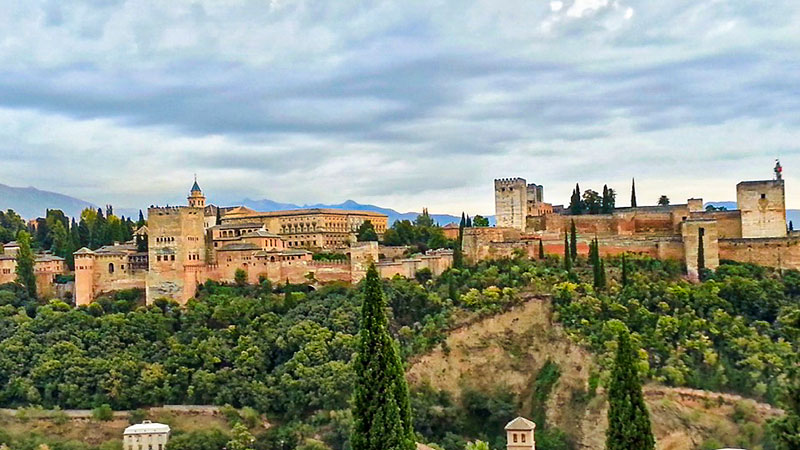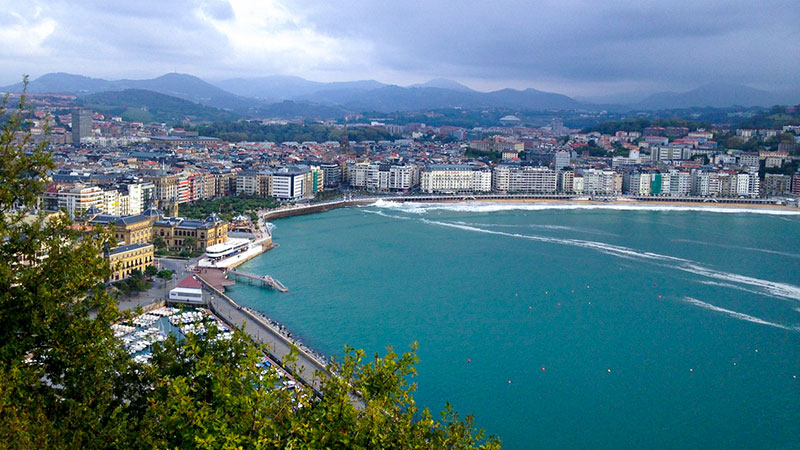NOTES FROM OUR TRAVELS
Iberia: Spain
Did You Know?
Spain has two completely different waterfronts. Its sunny Mediterranean side to the south is well known to vacationers and sun worshipers, but Spain also has a cool, breezy northern flank on the Atlantic Ocean. These quite different climates and geographies bring with them an array of cultural and culinary delights.
The Mercado de San Miguel in Madrid is the 1916 iron and glass market where the paths of locals and tourists intersect in the center of Madrid. It’s a great spot for eating and drinking, shopping for special treats and people watching.
Most every establishment makes its own vermouth, which is meant to be drunk with tapas or meals. It’s more a beverage to be enjoyed on its own than an ingredient for mixing cocktails. House vermouth is inexpensive and a delicious and authentic taste of Spain.

Churros are a favorite treat.

Madrid’s Mercado de San Miguel.
Spain’s South
Below, this famous bridge connects the old and new parts of Ronda spanning a gorge of dizzying proportions that’s deep enough to conceal a building some 30 stories tall! This Andalusian hill town in southwestern Spain inspired key scenes in Ernest Hemingway’s For Whom the Bell Tolls and is the home of the country’s oldest bull fighting ring.
Head to the far southwestern reaches of Spain, and Tarifa will be the last stop before Africa. With its stiff winds generated by its position where the Atlantic Ocean and the Mediterranean Sea meet, Tarifa is popular amongst Europeans for windsurfing. It’s just six miles from Gibraltar, with its crazy snack-stealing monkeys and famous rockface and a 45-minute ferry ride to Tangier, on Morocco’s northern coast.

A bridge connects old and new Ronda.

Tarifa, in the far southwest of Spain.
An Array of Culture
The spectacular Alhambra in the southern city of Granada is an incredible day’s exploration but also a lovely backdrop for dinner at any of a number of outdoor restaurants that line the hillside across from its western façade.
Flamenco is a passionate form of expression, whether it’s dance, singing or guitar. Partake of an evening of flamenco and you’ll get a glimpse into the soul of Spain.
One of Spain’s finest cured hams is Jamon Iberico Bellota, which comes from acorn-fed pigs in the forests of southwestern Spain. Penicillin roqueforti, the bacteria that gifts us with fabulous Roquefort cheese gives this ham a luscious flavor unique among the famous hams of Europe.
You may recognize Seville’s Plaza de España from Lawrence of Arabia or the more recent Star Wars movie, Attack of the Clones, but this is no mere movie set! While the building houses governmental functions, the plaza is a popular spot for walking, paddling in the canal and taking selfies. It’s situated next to Maria Luisa Park, where you can picnic, bike or go for a carriage ride.

The Alhambra in Granada, Spain.

Jamon Iberico Bellota, also know as ham.

Flamenco dancer and guitarist.

Seville’s Plaza de España.
Spain was home to some of the world’s most beloved artists, including Picasso, Miro, Dali and el Greco, and troves of their work are available to view in the country’s many splendid museums. Some works of art you can stroll right into, like Gaudi’s Sagrada Familia Basilica in Barcelona, replete with its dazzling, multicolored stained glass windows. His wavy architectural masterpieces are scattered about the city and make a nice change of pace when you’ve spent too much time indoors.
Donostia is the Basque name of San Sebastian, the crown jewel of the Basque territory, which straddles the border of Spain and France on the Atlantic side of both countries. The language there is Euskara, thought to be the world’s oldest tongue. A local Basque rail line connects towns up and down the Atlantic coastline, running from Bilbao as far north as Saint-Jean-de-Luz in France. Some of the world’s most highly respected restaurants are clustered in this small town.

Gaudi’s Sagrada Familia Basilica in Barcelona.

Donostia-San Sebastián, Spain
In the Spanish Basque country tapas are called pintxos and are more elaborately constructed than the basic—but still delicious—tapas you’ll enjoy in the rest of Spain.
Listen to Andres Segovia, mid-20th century Spanish guitarist who made the instrument “respectable” among classical music lovers.
The Camino de Santiago is the world’s most famous pilgrimage route, but there are several paths throughout Spain and Portugal you can walk to reach your destination in the northwestern region called Galicia. Check out the 2010 film The Way to get a glimpse of one man’s journey and the array of people he meets on the path.
When you visit Spain come hungry, for you’ll surely be well fed! You’ll be entertained, you’ll be wowed by the scenery, and you’ll be warmly welcomed.





